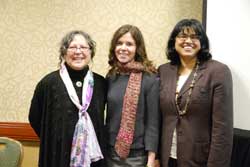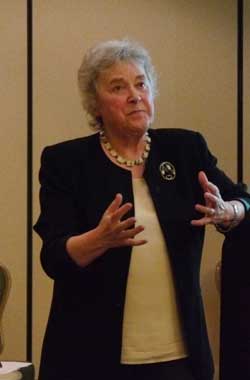Making the Case for Art Education
TC faculty and students weigh in at the National Art Education Association convention
TC faculty and students weigh in at the National Art Education Association convention
By Hua-Chu Yen
Exposure to the arts in early childhood is essential to the development of creativity and a sense of personal agency – but between budget cuts on the one hand and an emphasis on testing in core subjects on the other, American education is failing to provide young people with that critically important experience.
That message, urgently sounded by a cast of keynote speakers that included the renowned artists and educators Chuck Close, Janine Antoni, Eric Zimmerman, and John Maeda, was the predominant message delivered at the National Art Education Association (NAEA) convention, held this past spring in New York City. Titled Emerging Perspectives | Connecting Teaching, Learning, and Research, the convention included contributions by TC faculty and students of TC’s Art and Art Education program to more than 40 different sessions.
The meeting, which drew nearly 7,000 attendees from across the United States and around the world, was the largest in NAEA history.
Maeda, a graphic designer and computer scientist who currently serves as President of the Rhode Island School of Design, said his early childhood involvement with art gave him a sense of wonder that continue to animate his work. He decried the lack of emphasis the arts receive in contemporary discussions of education, noting their conspicuous absence from education initiatives such as the Science, Technology, Engineering, and Mathematics (STEM) Education Coalition.
Zimmerman, whose drawings, etchings and writings explore themes of social and political Utopias, blamed the No Child Left Behind legislation, which has increased standardized testing aimed at ensuring that all public schools achieve average yearly progress toward universal student proficiency in math and reading, for narrowing the curriculum in U.S. schools.
TC faculty member Judith Burton, Director of the College’s Art and Art Education program, sounded similar notes in her own presentation, Interweavings: What Excellent Visual Arts Teaching Looks Like. Burton said that a good teacher must possess “the reflective ability to envision knowledge from multiple viewpoints,” as well as “a rich and diverse understanding of the needs, interests and cognitive capacities of learners,” and “the imagination and flexibility to interweave personal context knowledge with insights about students.” Burton characterized the recent decision by New York City to release the performance ratings for 18,000 teachers based on student test scores as “a real failure to understand teaching and learning as a product of flow and the rich array of classroom events.”
Olga Hubard, Assistant Professor of Art Education, explored the ways in which making art could potentially inform the teaching of other subjects. Together with Michelle Knight, Associate Professor in Curriculum and Teaching, and Maria Torres-Guzman, Professor of Bilingual/Bicultural Education, Hubard described how engagement with an artistic process such as collage could encourage instructors from other disciplines to view their subjects from new and different viewpoints.
TC students made the case for art education through more visceral means, often incorporating hands-on activities into presentations that touched on themes ranging from gender studies to multiculturalism and teacher preparation. Grant Tedaldi, a TC doctoral student who is currently working for New York City’s Department of Education, showcased new graphics tools and shared new computer. Using an iPad equipped with an app called Adobe Color Lava for Photoshop, which links virtual experience with tactile experience, Tedaldi demonstrated the mixing of colors on screen.
At the end of Hubard’s presentation, one teacher in the audience voiced her frustration over having to constantly protect the art program at her school whenever budgets are on the line. She urged the university researchers present to publish their papers in the lay media as well as in peer-reviewed journals, so that “the general public will support teachers and encourage schools to see art as something they need to have rather than simply as something that it would be nice to have.”
Published Tuesday, May. 15, 2012


